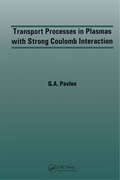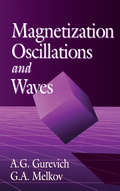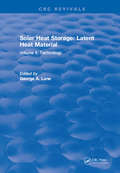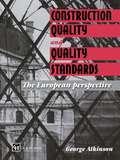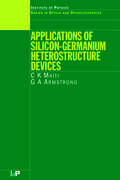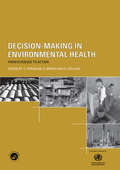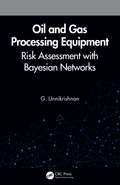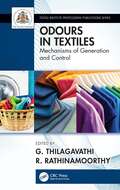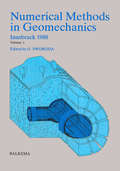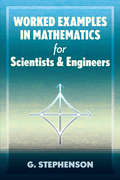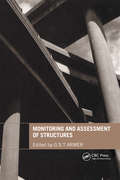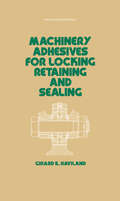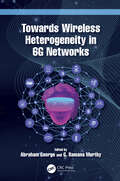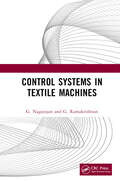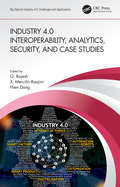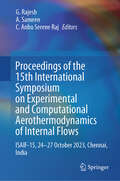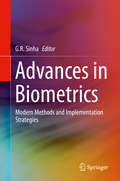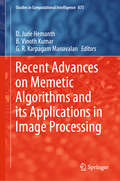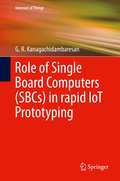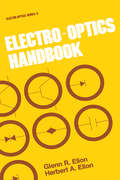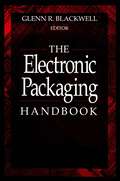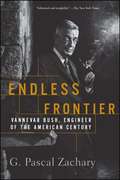- Table View
- List View
Transport Processes in Plasmas with Strong Coulomb Interactions
by G.A. PavlovThe first part of this monograph presents theoretical analysis of the thermophysical properties of strongly coupled coulomb systems. A new model is then developed, making it possible to calculate the full set of low temperature, multicomponent, nonideal plasma transport coefficients, based on the kinetic coefficients of strongly coupled coulomb sys
Magnetization Oscillations and Waves
by A.G. Gurevich G.A. MelkovWritten by two well-known researchers in the field, this useful reference takes an applied approach to high frequency processes including oscillations and waves in ferromagnets, antiferromagnets, and ferrimagnets. Problems evaluated include ferromagnetic and antiferromagnetic resonances, spin waves, nonlinear processes, and high frequency manifestations of interactions between the magnetic system and other systems of magnetically ordered substances as elastic waves and charge carriers.Unlike previous monographs on this subject, which are highly theoretical and written for very advanced readers, this book requires only an average college background in mathematics and experimental physics. It will be a valuable addition to the library of engineers and scientists in research and development for communications applications, and scientists interested in nonlinear magnetic phenomena. It also serves as an excellent introduction to the topic for newcomers in the field.Magnetization Oscillations and Waves not only presents results but also shows readers how to obtain them; most formulas are derived with so many details that readers can reproduce them. The book includes many summaries and tables and detailed references to significant work in the area by European researchers.
Material Inhomogeneities in Elasticity
by G.A. MauginSelf contained, this book presents a thorough introduction to the complementary notions of physical forces and material (or configurational) forces. All the required elements of continuum mechanics, deformation theory and differential geometry are also covered. This book will be a great help to many, whilst revealing to others a rather new facet of continuum mechanics in general, and elasticity in particular. An organized exposition of continuum mechanics on the material manifold is given which allows for the consideration of material inhomogeneities in their most appropriate framework. In such a frame the nonlinear elasticity of anisotropic inhomogenous materials appears to be a true field theory. Extensions to the cases of electroelasticity and magnetelasticity are then straightforward. In addition, this original approach provides systematic computational means for the evaluation of characteristic parameters which are useful in various branches of applied mechanics and mathematical physics. This is the case for path-independent integrals and energy-release rates in brittle fracture, the influence of electromagnetic fields on fracture criteria (such as in ceramics), the notion of momentum of electromagnetic fields in matter in optics, and the perturbation of solitons propagating in elastic dispersive systems.
Solar Heat Storage: Volume II: Latent Heat Material
by G.A. LaneSeveral hundred technically acceptable PCMs were identified in Volume I of this set, and some of their thermodynamic and physical properties were present. Out of these, practical considerations have reduced the list to a few commercial PCMs for solar energy thermal storage heating and cooling applications. In Volume II these PCMs and their technology and discussed.
Construction Quality and Quality Standards: The European perspective
by G.A. AtkinsonQuality is a vital issue to be addressed by all constuction professionals working in Europe today. This book provides clear, concise guidance to the making and use of codes, regulations and technical specifications in Europe.
Applications of Silicon-Germanium Heterostructure Devices (Series in Optics and Optoelectronics)
by C.K Maiti G.A ArmstrongThe first book to deal with the design and optimization of transistors made from strained layers, Applications of Silicon-Germanium Heterostructure Devices combines three distinct topics-technology, device design and simulation, and applications-in a comprehensive way. Important aspects of the book include key technology issues for the growth of st
Decision-Making in Environmental Health: From Evidence to Action
by D. Briggs C. Corvalan G. ZielhuisDecision-Making in Environmental Health examines the need for information in support of decision-making in environmental health. It discusses indicators of environmental health, methods of data collection and the assessment of exposure to and the health impact of different environmental risk factors.
Oil and Gas Processing Equipment: Risk Assessment with Bayesian Networks
by G. UnnikrishnanOil and gas industries apply several techniques for assessing and mitigating the risks that are inherent in its operations. In this context, the application of Bayesian Networks (BNs) to risk assessment offers a different probabilistic version of causal reasoning. Introducing probabilistic nature of hazards, conditional probability and Bayesian thinking, it discusses how cause and effect of process hazards can be modelled using BNs and development of large BNs from basic building blocks. Focus is on development of BNs for typical equipment in industry including accident case studies and its usage along with other conventional risk assessment methods. Aimed at professionals in oil and gas industry, safety engineering, risk assessment, this book Brings together basics of Bayesian theory, Bayesian Networks and applications of the same to process safety hazards and risk assessment in the oil and gas industry Presents sequence of steps for setting up the model, populating the model with data and simulating the model for practical cases in a systematic manner Includes a comprehensive list on sources of failure data and tips on modelling and simulation of large and complex networks Presents modelling and simulation of loss of containment of actual equipment in oil and gas industry such as Separator, Storage tanks, Pipeline, Compressor and risk assessments Discusses case studies to demonstrate the practicability of use of Bayesian Network in routine risk assessments
Odour in Textiles: Generation and Control (Textile Institute Professional Publications)
by G. ThilagavathiOdour in Textiles: Generation and Control presents the essential science and mechanisms behind the formation of odours in textiles. It discusses consumer perception of odour in clothing, the mechanism of odour formation in the skin, and the role of textile fibres and structures in odour formation. It also discusses odour controls and testing methods available for measurement of odours in textiles. Features: • Fills a gap in the literature as the first book to focus on textile and odour interaction • Discusses microbiological aspects of odour formation in simple terms • Details the role of textile fibres and structures on odour formation • Describes various testing methods, standards, and regulatory norms for odour analysis This book will appeal to a broad audience, including industry professionals in the textiles industry, hygiene and health care, the chemical and finishing industry, and odour measurement and testing. It will also interest advanced students and research scholars studying textile engineering, clothing science, and fashion design.
Handbook of Materials Selection for Engineering Applications
by G. T. MurrayReflecting the rapid advances in new materials development, this work offers up-to-date information on the properties and applications of various classes of metals, polymers, ceramics and composites. It aims to simplify the materials selection process and show how to lower materials and manufacturing costs, drawing on such sources as vendor supplie
Numerical Methods in Geomechanics Volume 1: Innsbruck, 1988
by G. SwobodaFirst Published in 2017. Routledge is an imprint of Taylor & Francis, an Informa company.
Worked Examples in Mathematics for Scientists and Engineers (Dover Books on Mathematics)
by G. StephensonThis rich collection of fully worked problems in many areas of mathematics covers all the important subjects students are likely to encounter in their courses, from introductory to final-year undergraduate classes. Because lecture courses tend to focus on theory rather than examples, these exercises offer a valuable complement to classroom teachings, promoting the understanding of mathematical techniques and helping students prepare for exams. They will prove useful to undergraduates in mathematics; students in engineering, physics, and chemistry; and postgraduate scientists looking for a way to refresh their skills in specific topics.The problems can supplement lecture notes and any conventional text. Starting with functions, inequalities, limits, differentiation, and integration, topics encompass integral inequalities, power series and convergence, complex variables, hyperbolic function, vector and matrix algebra, Laplace transforms, Fourier series, vector calculus, and many other subjects.
Monitoring and Assessment of Structures
by G. S. T. ArmerThis book details the latest methods available for the in-service assessment of buildings and other structures. Written by a team of international experts, it provides detailed information and practical advice on key issues such as safety assessment and performance monitoring and evaluation. All the leading methodologies are covered, including phot
Machinery Adhesives for Locking, Retaining, and Sealing (Dekker Mechanical Engineering Ser. #44)
by G. S. HavilandThe spaces left after the assembly of threaded, flanged and press fitted parts have always been a source of trouble. The amount of metal to metal contact between threads and heavy press fits varies between 20 and 30% of the total area inolved, which means that 70 to 80% is a do-nothing space. The object of this book is to guide the designer, process engineer, or mechanic in selecting and using anaerobic machinery adhesives effectively. It is the author's hope that students of engineering will also benefit from this book, so it includes the 'why' as well as the 'what' and 'how' about those materials.
Finite Element Analysis of Weld Thermal Cycles Using ANSYS
by G. RavichandranFinite Element Analysis of Weld Thermal Cycles Using ANSYS aims at educating a young researcher on the transient analysis of welding thermal cycles using ANSYS. It essentially deals with the methods of calculation of the arc heat in a welded component when the analysis is simplified into either a cross sectional analysis or an in-plane analysis. The book covers five different cases involving different welding processes, component geometry, size of the element and dissimilar material properties. A detailed step by step calculation is presented followed by APDL program listing and output charts from ANSYS. Features: Provides useful background information on welding processes, thermal cycles and finite element method Presents calculation procedure for determining the arc heat input in a cross sectional analysis and an in-plane analysis Enables visualization of the arc heat in a FEM model for various positions of the arc Discusses analysis of advanced cases like dissimilar welding and circumferential welding Includes step by step procedure for running the analysis with typical input APDL program listing and output charts from ANSYS.
Towards Wireless Heterogeneity in 6G Networks
by Abraham George G. Ramana MurthyThe connected world paradigm effectuated through the proliferation of mobile devices, Internet of Things (IoT), and the metaverse will offer novel services in the coming years that need anytime, anywhere, high-speed access. The success of this paradigm will highly depend on the ability of the devices to always obtain the optimal network connectivity for an application and on the seamless mobility of the devices. This book will discuss 6G concepts and architectures to support next-generation applications such as IoT, multiband devices, and high-speed mobile applications. IoT applications put forth significant challenges on the network in terms of spectrum utilization, latency, energy efficiency, large number of users, and supporting different application characteristics in terms of reliability, data rate, and latency.While the 5G network developmentwas motivated by the need for larger bandwidth and higher quality of service (QoS), 6G considerations are supporting many users with a wide application requirement, lowering network operating cost, and enhanced network flexibility. Network generations beyond 5G are expected to accommodate massive number of devices with the proliferation of connected devices concept in connected cars, industrial automation, medical devices, and consumer devices.This book will address the fundamental design consideration for 6G networks and beyond. There are many technical challenges that need to be explored in the next generation of networks, such as increased spectrum utilization, lower latency, higher data rates, accommodating more users, heterogeneous wireless connectivity, distributed algorithms, and device-centric connectivity due to diversified mobile environments and IoT application characteristics. Since 6G is a multidisciplinary topic, this book will primarily focus on aspects of device characteristics, wireless heterogeneity, traffic engineering, device-centric connectivity, and smartness of application.
Control Systems in Textile Machines
by G. Nagarajan G. RamakrishnanThis book details the mechanics of textile machines and covers the fundamental concepts and advanced applications of their control systems. It presents conceptual information, discusses practical equipment, and analyses the machines used in various stages of the spinning process.Print edition not for sale in South Asia (India, Sri Lanka, Nepal, Bangladesh, Pakistan or Bhutan)
Industry 4.0 Interoperability, Analytics, Security, and Case Studies (Big Data for Industry 4.0)
by G. Rajesh, X. Mercilin Raajini, and Hien DangAll over the world, vast research is in progress on the domain of Industry 4.0 and related techniques. Industry 4.0 is expected to have a very high impact on labor markets, global value chains, education, health, environment, and many social economic aspects. Industry 4.0 Interoperability, Analytics, Security, and Case Studies provides a deeper understanding of the drivers and enablers of Industry 4.0. It includes real case studies of various applications related to different fields, such as cyber physical systems (CPS), Internet of Things (IoT), cloud computing, machine learning, virtualization, decentralization, blockchain, fog computing, and many other related areas. Also discussed are interoperability, design, and implementation challenges. Researchers, academicians, and those working in industry around the globe will find this book of interest. FEATURES Provides an understanding of the drivers and enablers of Industry 4.0 Includes real case studies of various applications for different fields Discusses technologies such as cyber physical systems (CPS), Internet of Things (IoT), cloud computing, machine learning, virtualization, decentralization, blockchain, fog computing, and many other related areas Covers design, implementation challenges, and interoperability Offers detailed knowledge on Industry 4.0 and its underlying technologies, research challenges, solutions, and case studies
Proceedings of the 15th International Symposium on Experimental and Computational Aerothermodynamics of Internal Flows: ISAIF-15, 24–27 October 2023, Chennai, India
by G. Rajesh A. Sameen C. Anbu Serene RajThis book is a carefully curated collection of technical research papers presented at the 15th International Symposium on Experimental and Computational Aerothermodynamics of Internal Flows (ISAIF-15). It highlights the latest advancements in experimental and computational studies of internal flows, covering diverse and cutting-edge topics. The proceedings feature significant research on shock wave-boundary layer interactions, aeroacoustics of supersonic jets, and the dynamics of pulsatile fluid flows. Studies on multiphase flows, biofluid dynamics, and heat transfer with hydrophobic coatings underscore the interdisciplinary nature of the work. Advanced numerical simulations, including models of biomagnetic flows, red blood cell migration, and ejector-diffuser systems in high-altitude testing, are also showcased. Practical applications such as improving aerodynamic efficiency for high-speed trains, mitigating shock wave effects, and enhancing supersonic ejector performance are explored alongside theoretical advancements. This ensures a balanced perspective on the challenges and opportunities in aerothermodynamics. Aimed at academics, researchers, and industry professionals, this book bridges theoretical principles with real-world applications. Each chapter reflects rigorous scientific inquiry, offering insights into innovative methodologies, computational models, and practical solutions. It serves as a definitive resource for those seeking to understand and advance the state-of-the-art in fluid dynamics and aerospace engineering. Whether you are delving into flow control, heat transfer, or the intricacies of combustion dynamics, this book provides a comprehensive repository of knowledge, inspiring future research and fostering innovation in the field of aerothermodynamics
Advances in Biometrics: Modern Methods and Implementation Strategies
by G. R. SinhaThis book provides a framework for robust and novel biometric techniques, along with implementation and design strategies. The theory, principles, pragmatic and modern methods, and future directions of biometrics are presented, along with in-depth coverage of biometric applications in driverless cars, automated and AI-based systems, IoT, and wearable devices. Additional coverage includes computer vision and pattern recognition, cybersecurity, cognitive computing, soft biometrics, and the social impact of biometric technology. The book will be a valuable reference for researchers, faculty, and practicing professionals working in biometrics and related fields, such as image processing, computer vision, and artificial intelligence.Highlights robust and novel biometrics techniquesProvides implementation strategies and future research directions in the field of biometricsIncludes case studies and emerging applications
Recent Advances on Memetic Algorithms and its Applications in Image Processing (Studies in Computational Intelligence #873)
by D. Jude Hemanth B. Vinoth Kumar G. R. Karpagam ManavalanThis book includes original research findings in the field of memetic algorithms for image processing applications. It gathers contributions on theory, case studies, and design methods pertaining to memetic algorithms for image processing applications ranging from defence, medical image processing, and surveillance, to computer vision, robotics, etc. The content presented here provides new directions for future research from both theoretical and practical viewpoints, and will spur further advances in the field.
Role of Single Board Computers (Internet of Things)
by G. R. KanagachidambaresanThis book presents how to program Single Board Computers (SBCs) for Internet of Things (IoT) rapid prototyping with popular tools such as Raspberry Pi, Arduino, Beagle Bone, and NXP boards. The book provides novel programs to solve new technological real-time problems. The author addresses programming, PCB design and Mechanical Cad design all in single volume, easing learners into incorporating their ideas as prototype. The aim of the book is to provide programming, sensors interfacing, PCB design, and Mechanical Cad design to and create rapid prototyping. The author presents the methodologies of rapid prototyping with KiCAD design and Catia software, used to create ready to mount solutions. The book covers scripting- based and drag/drop- based programming for different problems and data gathering approach.
Electro-Optics Handbook
by G. R. ElionThis handbook covers the entire practice of electro-optic engineering, and is prepared as a service to the entire engineering profession. It is useful for industry, military practice, engineering education, and technical training.
The Electronic Packaging Handbook (Electronics Handbook Series)
by G. R. BlackwellThe packaging of electronic devices and systems represents a significant challenge for product designers and managers. Performance, efficiency, cost considerations, dealing with the newer IC packaging technologies, and EMI/RFI issues all come into play. Thermal considerations at both the device and the systems level are also necessary.The Electronic Packaging Handbook, a new volume in the Electrical Engineering Handbook Series, provides essential factual information on the design, manufacturing, and testing of electronic devices and systems.Co-published with the IEEE, this is an ideal resource for engineers and technicians involved in any aspect of design, production, testing or packaging of electronic products, regardless of whether they are commercial or industrial in nature. Topics addressed include design automation, new IC packaging technologies, materials, testing, and safety.Electronics packaging continues to include expanding and evolving topics and technologies, as the demand for smaller, faster, and lighter products continues without signs of abatement. These demands mean that individuals in each of the specialty areas involved in electronics packaging-such as electronic, mechanical, and thermal designers, and manufacturing and test engineers-are all interdependent on each others knowledge. The Electronic Packaging Handbook elucidates these specialty areas and helps individuals broaden their knowledge base in this ever-growing field.
Endless Frontier: Vannevar Bush, Engineer of the American Century
by G. Pascal ZacharyA prodigiously researched biography of Vannevar Bush, one of America’s most awe-inspiring polymaths and the secret force behind the biggest technological breakthroughs of the twentieth century.As the inventor and public entrepreneur who launched the Manhattan Project, helped to create the military-industrial complex, conceived a permanent system of government support for science and engineering, and anticipated both the personal computer and the Internet, Vannevar Bush is the twentieth century’s Ben Franklin. In this engaging look at one of America’s most awe-inspiring polymaths, writer G. Pascal Zachary brings to life an American original—a man of his time, ours, and beyond. Zachary details how Bush cofounded Raytheon and helped build one of the most powerful early computers in the world at MIT. During World War II, he served as Roosevelt’s adviser and chief contact on all matters of military technology, including the atomic bomb. He launched the Manhattan Project and oversaw a collection of 6,000 civilian scientists who designed scores of new weapons. After the war, his attention turned to the future. He wrote essays that anticipated the rise of the Internet and boldly equated national security with research strength, outlining a system of permanent federal funding for university research that endures to this day. However, Bush’s hopeful vision of science and technology was leavened by an understanding of the darker possibilities. While cheering after witnessing the Trinity atomic test, he warned against the perils of a nuclear arms race. He led a secret appeal to convince President Truman not to test the Hydrogen Bomb and campaigned against the Red Scare. Elegantly and expertly relayed by Zachary, Vannevar’s story is a grand tour of the digital leviathan we know as the modern American life.
